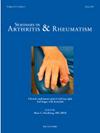使用ASDAS评估轴型脊柱炎患者的疾病活动性和对治疗的反应:是否遵循了ASAS的建议?
IF 4.4
2区 医学
Q1 RHEUMATOLOGY
引用次数: 0
摘要
目的:确定在开始第一次bDMARD治疗后的基线和两次随访中至少有一次ASDAS的轴性脊柱炎(axSpA)患者的比例;并评估在3个月和6个月时满足ASAS标准继续治疗的可能性。方法纳入来自Reuma.pt注册中心的axSpA患者,他们开始了他们的第一次bDMARD,并参加了基线,3个月(3个月)和6个月(6个月)的访问。基线时ASDAS的可用性与≥1次随访时的可用性交叉表。当没有ASDAS时,评估替代结果测量的使用。3 M和6 M时的治疗反应(∆ASDAS≥1.1)分为四种反应模式:无反应、仅3 M、仅6 M或两者兼有。结果共纳入666例患者。大多数在基线时患有ASDAS (N = 540;81%), 493例(74%)在3 M和/或6 M时也有ASDAS。当ASDAS缺失时,没有其他主要的结果测量方法。在336例完成ASDAS评估的患者中,58%的患者在3 M和6 M时满足ASAS持续标准,86%的患者在3 M和6 M之间维持反应。此外,147例3 M无反应者中有25%在6 M时有反应。两个时间点的反应者通常是男性(65%对45%)和年轻(平均年龄35岁对38岁)。结论asdas在开始bdmard的axSpA患者中被葡萄牙风湿病学家广泛评估。大多数患者在3个月内出现反应,但等到6个月后再决定是否继续治疗是合理的。本文章由计算机程序翻译,如有差异,请以英文原文为准。
The use of ASDAS to evaluate disease activity and response to treatment in patients with axial spondyloarthritis starting the first biological drug: Are ASAS recommendations being followed?
Objectives
To determine the proportion of patients with axial spondyloarthritis (axSpA) who had ASDAS calculated at baseline and at least once within two follow-up visits after starting their first bDMARD; and to evaluate the likelihood of meeting ASAS criteria for treatment continuation at 3 and 6 months.
Methods
Patients with axSpA from the Reuma.pt registry who initiated their first bDMARD and attended baseline, 3-month (3 M), and 6-month (6 M) visits were included. Availability of ASDAS at baseline was cross-tabulated with its availability in ≥1 follow-up visit. When ASDAS was absent, the use of alternative outcome measures was evaluated. Treatment response (∆ASDAS ≥1.1) at 3 M and 6 M was analyzed across four response patterns: no response, 3 M only, 6 M only, or both.
Results
A total of 666 patients were included. Most had ASDAS at baseline (N = 540; 81 %), and 493 (74 %) also had ASDAS at 3 M and/or 6 M. No alternative outcome measure was predominantly used when ASDAS was absent. Among 336 patients with complete ASDAS evaluation, 58 % met ASAS continuation criteria at 3 M and 60 % at 6 M, with 86 % of response maintenance between 3 M and 6 M. Additionally, 25 % of 147 non-responders at 3 M responded at 6 M. Responders at both timepoints were more often male (65 % vs 45 %) and younger (mean age 35 vs 38 years).
Conclusion
ASDAS is widely assessed in axSpA patients starting bDMARDs by Portuguese rheumatologists. Most patients respond within 3 months but waiting until 6 months to determine treatment continuation is reasonable.
求助全文
通过发布文献求助,成功后即可免费获取论文全文。
去求助
来源期刊
CiteScore
9.20
自引率
4.00%
发文量
176
审稿时长
46 days
期刊介绍:
Seminars in Arthritis and Rheumatism provides access to the highest-quality clinical, therapeutic and translational research about arthritis, rheumatology and musculoskeletal disorders that affect the joints and connective tissue. Each bimonthly issue includes articles giving you the latest diagnostic criteria, consensus statements, systematic reviews and meta-analyses as well as clinical and translational research studies. Read this journal for the latest groundbreaking research and to gain insights from scientists and clinicians on the management and treatment of musculoskeletal and autoimmune rheumatologic diseases. The journal is of interest to rheumatologists, orthopedic surgeons, internal medicine physicians, immunologists and specialists in bone and mineral metabolism.

 求助内容:
求助内容: 应助结果提醒方式:
应助结果提醒方式:


